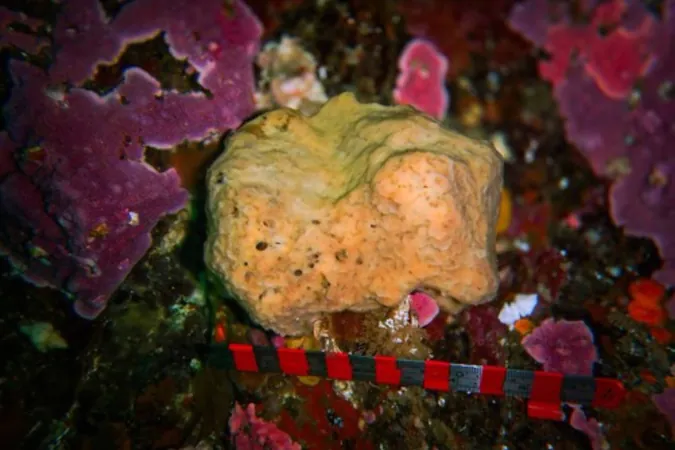
Sea Sponge 'Sneezes' in British Columbia: Fascinating Discovery Unveils Complex Behaviors
2025-01-07
Author: Siti
Groundbreaking Study Reveals Unusual Behavior
A groundbreaking study on a sea sponge off the coast of British Columbia has unveiled its surprising ability to 'sneeze,' demonstrating behaviors reminiscent of higher animals. Researchers at the University of Alberta, led by marine biologist Sally Leys, monitored the sponge's reactions to environmental changes over four years using sophisticated underwater cameras set up by Ocean Networks Canada.
Sneeze-Like Contractions and Adaptability
The team captured extensive footage that revealed the sponge's ability to perform prolonged “sneeze-like” contractions—efforts to expel debris while filter feeding. "If you introduce dirt onto the sponge, it becomes an irritant, and the sponge has a clever way of dealing with it," Leys explained. "It wraps the irritants in mucus and expels them, albeit slowly." Interestingly, the sponge's sneeze-like behavior varied with size; smaller sponges could clear irritants in about 40 minutes to an hour, while the sponge named Belinda, roughly the size of a human fist, took up to a day. This adaptability showcases how marine life can mitigate the challenges posed by their environment.
Observation Reveals Dynamic Nature
Despite appearing unresponsive at a glance, long-term observation revealed Belinda's dynamic nature. "I was amazed at how active it was," Leys remarked. "This sponge was constantly moving and exhibiting various behaviors, which you wouldn’t expect just from looking at it."
Seasonal Changes and Dormancy
The study, recently published in *Marine Ecology Progress Series*, monitored Belinda's daily, seasonal, and annual changes in size, shape, and color. The researchers amassed hundreds of hours of video analysis from footage taken about 25 meters below the surface off Vancouver Island. They discovered that during the winter months, the sponge would contract and enter a dormant state, a behavior surprising given its lack of muscles and a nervous system.
Intriguing Mechanisms Without a Nervous System
"What's intriguing is that this mechanism doesn't seem to require a nervous system; there appears to be an innate response to changes in food availability," Leys noted. "It raises fascinating questions about how these organisms adapt and regulate their activity levels."
Impact of Environmental Factors
In warmer months, as phytoplankton blooms increase particulates in the water, researchers observed the sponge re-expanding, used as a natural regrowth mechanism. This finding provides valuable insight into how environmental factors influence sponge behavior, which is crucial as climate change continues to impact ocean ecosystems.
Long-Term Observations and Future Research
Even after the project's conclusion in 2015, divers monitoring the area reported that Belinda is still thriving, having regained its vibrant color. Leys hopes to re-establish the underwater camera system to further investigate the sponge's long-term behaviors and adapt to the evolving ocean conditions.
Broader Implications for Conservation
With the potential for another decade of observations, Leys believes that renewed study could help unveil the broader impacts of climate change on sponges and the marine environment. "Understanding how sponges operate can illuminate patterns that correlate with larger oceanic changes, helping to inform conservation strategies," she emphasized.
Conclusion: Insights into Marine Life
As researchers focus more on the responses of marine life to changing ecosystems, the 'sneezing' sponge serves as an intriguing case that pushes the boundaries of our understanding of animal behavior in the sea. Who knew that beneath the waves, a tiny creature could reveal so much about the complex interactions of life and environment? Stay tuned for more exciting marine discoveries!
 Brasil (PT)
Brasil (PT)
 Canada (EN)
Canada (EN)
 Chile (ES)
Chile (ES)
 Česko (CS)
Česko (CS)
 대한민국 (KO)
대한민국 (KO)
 España (ES)
España (ES)
 France (FR)
France (FR)
 Hong Kong (EN)
Hong Kong (EN)
 Italia (IT)
Italia (IT)
 日本 (JA)
日本 (JA)
 Magyarország (HU)
Magyarország (HU)
 Norge (NO)
Norge (NO)
 Polska (PL)
Polska (PL)
 Schweiz (DE)
Schweiz (DE)
 Singapore (EN)
Singapore (EN)
 Sverige (SV)
Sverige (SV)
 Suomi (FI)
Suomi (FI)
 Türkiye (TR)
Türkiye (TR)
 الإمارات العربية المتحدة (AR)
الإمارات العربية المتحدة (AR)